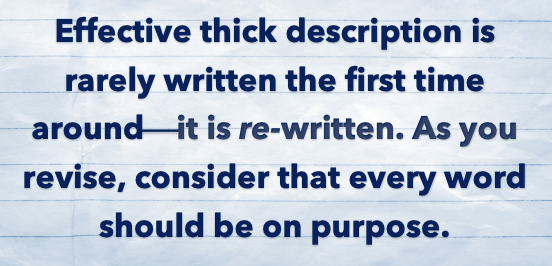Techniques
Imagery and Experiential Language
Strong description helps a reader experience what you’ve experienced, whether it was an event, an interaction, or simply a place. Even though you could never capture it perfectly, you should try to approximate sensations, feelings, and details as closely as you can. Your most vivid description will be that which gives your reader a way to imagine being themselves as of your story.
Imagery is a device that you have likely encountered in your studies before: it refers to language used to ‘paint a scene’ for the reader, directing their attention to striking details.
Here are a few examples
- Bamboo walls, dwarf banana trees, silk lanterns, and a hand-size jade Buddha on a wooden table decorate the restaurant. For a moment, I imagined I was on vacation. The bright orange lantern over my table was the blazing hot sun and the cool air currents coming from the ceiling fan caused the leaves of the banana trees to brush against one another in soothing crackling sounds.14
- The sunny midday sky calls to us all like a guilty pleasure while the warning winds of winter tug our scarves warmer around our necks; the City of Roses is painted the color of red dusk, and the setting sun casts her longing rays over the Eastern shoulders of Mt. Hood, drawing the curtains on another crimson-grey day.15
- Flipping the switch, the lights flicker—not menacingly, but rather in a homey, imperfect manner. Hundreds of seats are sprawled out in front of a black, worn down stage. Each seat has its own unique creak, creating a symphony of groans whenever an audience takes their seats. The walls are adorned with a brown mustard yellow, and the black paint on the stage is fading and chipped.16

"Busy Market" by Henry Sudarman is licensed under CC BY-NC-ND 2.0
You might notice, too, that the above examples appeal to many different senses. Beyond just visual detail, good imagery can be considered sensory language: words that help me see, but also words that help me taste, touch, smell, and hear the story. Go back and identify a word, phrase, or sentence that suggests one of these nonvisual sensations; what about this line is so striking?
Imagery might also apply figurative language to describe more creatively. Devices like metaphor, simile, and personification, or hyperbole can enhance description by pushing beyond literal meanings.
Using imagery, you can better communicate specific sensations to put the reader in your shoes. To the best of your ability, avoid clichés (stock phrases that are easy to ignore) and focus on the particular (what makes a place, person, event, or object unique). To practice creating imagery, try the Imagery Inventory exercise and the Image Builder graphic organizer in the Activities section of this chapter.
Thick Description
If you’re focusing on specific, detailed imagery and experiential language, you might begin to feel wordy: simply piling up descriptive phrases and sentences isn’t always the best option. Instead, your goal as a descriptive writer is to make the language work hard. Thick description refers to economy of language in vivid description. While good description has a variety of characteristics, one of its defining features is that every word is on purpose, and this credo is exemplified by thick description.
Thick description as a concept finds its roots in anthropology, where ethnographers seek to portray deeper context of a studied culture than simply surface appearance.17 In the world of writing, thick description means careful and detailed portrayal of context, emotions, and actions. It relies on specificity to engage the reader. Consider the difference between these two descriptions:
|
The market is busy. There is a lot of different produce. It is colorful.
|
vs.
|
Customers blur between stalls of bright green bok choy, gnarled carrots, and fiery Thai peppers. Stopping only to inspect the occasional citrus, everyone is busy, focused, industrious. |
Notice that, even though the description on the right is longer, its major difference is the specificity of its word choice. The author names particular produce, which brings to mind a sharper image of the selection, and uses specific adjectives. Further, though, the words themselves do heavy lifting—the nouns and verbs are descriptive too! “Customers blur” both implies a market (where we would expect to find “customers”) and also illustrates how busy the market is (“blur” implies speed), rather than just naming it as such.

Consider the following examples of thick description
- I had some strength left to wrench my shoulders and neck upward but the rest of my body would not follow. My back was twisted like a contortionist’s.18
- Shaking off the idiotic urge to knock, I turned the brass knob in my trembling hands and heaved open the thick door. The hallway was so dark that I had to squint while clumsily reaching out to feel my surroundings so I wouldn’t crash into anything.19
- Snow-covered mountains, enormous glaciers, frozen caves and massive caps of ice clash with heat, smoke, lava and ash. Fields dense with lush greenery and vibrant purple lupine plants butt up against black, barren lands scorched by eruptions. The spectacular drama of cascading waterfalls, rolling hills, deep canyons and towering jagged peaks competes with open expanses of flat, desert-like terrain.20
Where do you see the student authors using deliberate, specific, and imagistic words and phrases? Where do you see the language working hard?
Unanticipated and Eye-catching Language
In addition to our language being deliberate, we should also strive for language that is unanticipated. You should control your language, but also allow for surprises—for you and your reader! Doing so will help you maintain attention and interest from your reader because your writing will be unique and eye-catching, but it also has benefits for you: it will also make your writing experience more enjoyable and educational.
How can you be surprised by your own writing, though? If you’re the author, how could you not know what you’re about to say? To that very valid question, I have two responses:
- On a conceptual level: Depending on your background, you may currently consider drafting to be thinking-then-writing. Instead, you should try thinking-through-writing: rather than two separate and sequential acts, embrace the possibility that the act of writing can be a new way to process through ideas. You must give yourself license to write before an idea is fully formed—but remember, you will revise, so it’s okay to not be perfect. (I highly recommend Anne Lamott’s “Shitty First Drafts.”)
- On a technical level: Try out different activities—or even invent your own—that challenge your instincts. Rules and games can help you push beyond your auto-pilot descriptions to much more eye-catching language!
Constraint-based writing is one technique like this. It refers to a process which requires you to deliberately work within a specific set of writing rules, and it can often spark unexpected combinations of words and ideas. The most valuable benefit to constraint-based writing, though, is that it gives you many options for your descriptions: because first idea ≠ best idea, constraint-based writing can help you push beyond instinctive descriptors.
When you spend more time thinking creatively, the ordinary can become extraordinary. The act of writing invites discovery! When you challenge yourself to see something in new ways, you actually see more of it. Try the Dwayne Johnson activity to think more about surprising language.

"Kansas Summer Wheat and Storm Panorama" by James Watkins is licensed under CC BY 2.0




